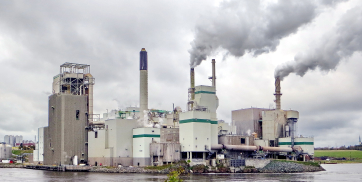News: Two Alberta Producers Claim “Net-Negative” Emissions
Enhance Energy and Whitecap Resources are using carbon capture technology to achieve “net-negative” emissions. Enhance Energy practices enhanced oil recovery (EOR) by acquiring waste C02 from a refinery plant and a fertilizer plant and injecting it into an old oil reservoir to increase production. Because they are only extracting a small amount of crude, Enhance Energy ends up storing more C02 underground than their oil will produce. Company executives claim that ~$4,000 tonnes of C02 are stored per day – the equivalent of “taking 350,000 vehicles off the road”. Read more here.
News: BlackRock Compels Corporate Climate Action
BlackRock chief Laurence D. Fink is one of the world’s most powerful investors, controlling ~$9 trillion. Last year, following an urgent letter from Fink on the importance of addressing climate change, Microsoft, Salesforce, Delta, and other large corporations announced climate change plans. In this year’s letter, Fink calls on all companies “to disclose a plan for how their business model will be compatible with a net-zero economy.” Read about how Mr. Fink’s influence is causing companies to scramble to implement their climate change plans here.
Report: Refinitiv Survey Sees Strong Future for EU ETS
Refinitiv has released their 2020 annual review of carbon markets. Most survey participants believe that the European Union Emissions Trading System (EU ETS) will be the most influential lever for emissions reductions. This is different from results from the 2019 survey, in which most respondents believed that national climate change policies held the most sway. Over half of respondants also believe that the EU will increase its 2030 target to 50% as part of the European Green Deal. Read more about the results of the 2020 survey here.
News: Calgary-based Clairifi ranks top-5 of 158 carbon accounting solutions
Of 158 companies offering carbon accounting solutions in a recent study, Clairifi was ranked in the top five. Clairifi’s cloud-based interactive platform makes methane reduction requirements easy to understand and minimizes the burden of emission quantification and reporting. They offer real-time insights and projections based on quantified monthly emission rates from multiple sources. Compliance reports are automatically created for multiple regulatory requirements. Learn about the top 5 carbon emissions management solutions here.
News: Microsoft Buys 1.3 Million Forestry and Soil Carbon Offsets
Microsoft has announced plans to be carbon negative by 2030. The 1.3 million metric tonnes of greenhouse gas emissions offset credits that Microsoft purchased for 2021 are part of that effort. Most of the credits came from forestry projects, and the rest from bioenergy. In 2019, Microsoft emitted 12 million tonnes globally. In 2020, they reduced their emissions by 587,000 tonnes. By 2030, they anticipate their emissions to be 5 million tonnes and plan to offset the amount to achieve net-zero emissions. By 2050, Microsoft plans to remove their entire historical C02 emissions. Read about Microsoft’s climate change actions here.
News: China launches National Emissions Trading Scheme
As part of its efforts to achieve carbon neutrality by 2060, China is launching a national carbon emissions trading scheme on February 1, 2021. All sectors emitting >26,000 tonnes per year will be included. China’s 2,225 power plants are key targets in their plan to control carbon emissions, however industries such as steel, paper, aviation, and cement will gradually be included in the ETS. Read more about China’s ETS here.
News: O&G Credit Ratings Could be Downgraded
Major oil and gas producers may soon see their credit ratings downgraded. S&P Global Ratings see these companies as a growing risk due to oil and gas price fluctuations, the energy transition process, and future profitability. Credit ratings from 13 major oil companies including Chevron, Shell, Total, and ExxonMobil may be downgraded in a few weeks. Read about it here.
Research: Mexico Offshore Methane >10x Lower than Inventories, Onshore >10x Higher
A recent study published in ERL by an international research collaboration examined methane emissions from both onshore and offshore production in Mexico. The researchers used a combination of approaches to estimate emissions, including two satellites, regional aircraft measurements, facility-scale aircraft measurements, and inventory data to better understand methane sources. Results suggest that official emissions inventories in Mexico are overestimating offshore emissions by an order of magnitude and underestimating onshore emissions by approximately the same amount. A single onshore facility was found to emit nearly 6,000 kg of methane per hour, largely due to inefficient flaring, which represents nearly half of the natural gas consumed residentially in all of Mexico. Read more here.
JWN Course
On April 27, Highwood’s CEO, Jessica Shumlich, will deliver a course on building inventories, quantifying, and reporting Scope 1 GHG emissions from upstream oil & gas facilities. If you haven’t already, sign up for the course here.




